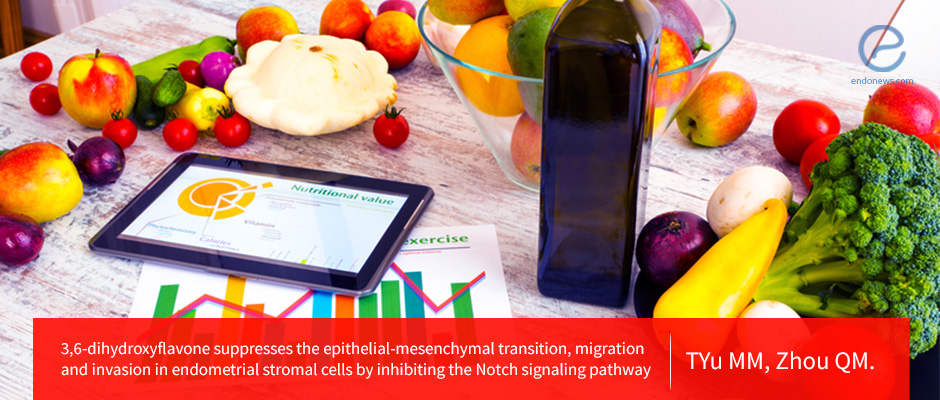3,6-DHF suppresses the invasive properties of endometrial stromal cells through the Notch signaling
Aug 5, 2018
The Role of 3,6-dihydroxyflavone (3,6-DHF) in Endometriosis.
Key Points
Highlight:
- 3,6-dihydroxyflavone (DHF), a polyphenolic compound, can inhibit the development of EMT, migration, and invasion of endometrial stromal cells by inhibiting the Notch signaling pathway.
Importance:
- 3,6-DHF has an antioxidative effect to be associated with lowering DNA damage, malignant transformation, cell damage, hence may have a negative effect on the development of endometriosis.
Background:
- Endometriosis is a common disease in women of reproductive age.
- Characteristics of endometriosis include invasion, metastasis, and recurrence, which are similar to those of malignant tumors.
- The etiology and pathogenesis of endometriosis are still not clear.
- Recent studies have found that 3,6-DHF can significantly inhibit the development of breast cancer. However, the function of 3,6-DHF has not been reported in endometriosis.
- In this study, Dr. Zhou group from China explore the mechanism of 3,6-DHF in the development of endometriosis.
Key results:
- 3,6-DHF inhibited the development of epithelial-to-mesenchymal transition (EMT) in ovarian ectopic endometrial stromal cells (OvESCs).
- Decreased expression of E-cadherin, as well as increased expressions of N-cadherin, Twist, Snail, and Slug, are important features of EMT.
- With the increased concentration of 3,6-DHF in OvESCs, the protein and mRNA expressions of E-cadherin were gradually increased, while the protein and mRNA expressions of N-cadherin, Twist, Snail, and Slug were decreased.
- 3,6-DHF treatment inhibited the migration and invasion ability of OvESCs in a dose-dependent manner.
- 3,6-DHF reduced the ectopic lesion size in the in vivo endometriosis model.
- In the endometriosis model of severe combined immunodeficient (SCID) mice, lesions in the 3,6-DHF treated group were significantly smaller than those of the control group.
- The same changes were found in the endometriosis model of Sprague Dawley (SD) rats.
- 3,6-DHF inhibited proteins related to the Notch signaling pathway and formation of NICD-CSL-MAML transcriptional complex in ectopic endometrial cells
- Protein expressions of Notch1, NICD, and Hes-1 in OvESCs were inhibited by 3,6-DHF in a dose-dependent manner.
- 3,6-DHF can inhibit the binding of NICD-CSL-MAML complex in OvESCs, thereby inhibiting the expressions of proteins related to the Notch signaling pathway in vitro.
Lay Summary
Dr. Zhou group reported recently that 3,6-DHF can inhibit the development of EMT, migration, and invasion of endometrial stromal cells by inhibiting the Notch signaling pathway.
Endometriosis is a condition in which the layer of tissue (glands and mesenchyme) that normally covers the inside of the uterus grows and infiltrates outside of it. Studies have found that adhesion, invasion, and growth of endometriosis are regulated by multiple factors. Interaction of epithelial and interstitial cells, especially epithelial-to-mesenchymal transition (EMT), may exert an essential role in the complex biological process of endometriosis. Researches have shown that EMT is active in ectopic endometriotic tissue compared with those of non-endometriosis tissue and eutopic endometriotic tissue. Further studies illustrated that the signaling pathways involved in the development and regulation of EMT include the Notch signaling pathway, TGF-β/Smad signaling pathway, etc. Studies have found that 3,6-DHF can significantly inhibit the development of breast cancer.
3,6-dihydroxyflavone (DHF), a polyphenolic compound, and has an antioxidative effect to be associated with lowering DNA damage, malignant transformation, cell damage, hence may have a negative effect on the development of endometriosis. The function of 3,6-DHF has not been examined or reported in endometriosis yet. Therefore, it is of great significance to study the function of 3,6-DHF in endometriosis.
Primary cultured ovarian ectopic endometrial stromal cells (OvESCs) were utilized as the in vitro model of endometriosis. With the increased concentration of 3,6-DHF in OvESCs, the protein and mRNA expressions of E-cadherin were gradually increased. Also, the protein and mRNA expressions of N-cadherin, Twist, Snail, and Slug were decreased. This suggests that 3,6-DHF inhibit the development of EMT. 3,6-DHF treatment inhibited the migration and invasion ability of OvESCs in a dose-dependent manner. In the endometriosis model of severe combined immunodeficient (SCID) mice, lesions in the 3,6-DHF treated group were significantly smaller than those of the control group. The same changes were found in the endometriosis model of rats. Protein expressions of Notch1, NICD, and Hes-1 in OvESCs were inhibited by 3,6-DHF in a dose-dependent manner. 3,6-DHF can inhibit the binding of NICD-CSL-MAML complex in OvESCs, thereby inhibiting the expressions of proteins related to the Notch signaling pathway in vitro.
Research Source: https://www.ncbi.nlm.nih.gov/pubmed/29949177
Endometriosis 3 6-dihydroxyflavone Notch Epithelial- mesenchymal transition polyphenol antioxidant invasion

